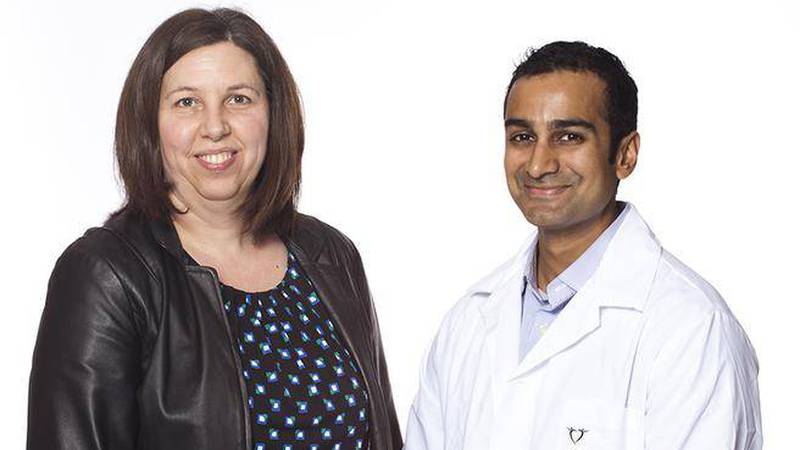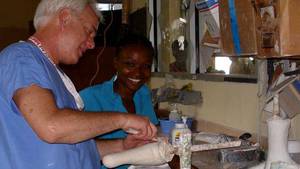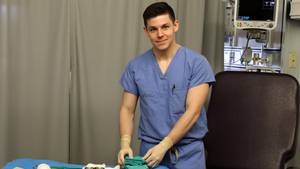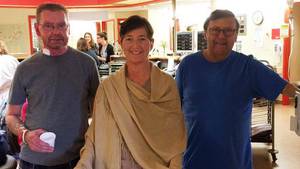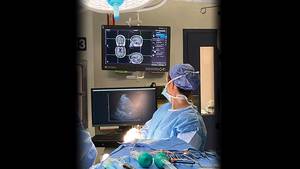By incorporating electronic communication into health care, physicians can improve treatment by building flexibility around a patient’s schedule. This is the future of health care says Dr. Karthik Tennankore, a physician at the QEII’s Department of Nephrology.
Dr. Tennankore is getting the chance to test this idea alongside Cynthia Stockman, the health services manager for outpatient nephrology. Their idea was one of the first to receive funding from the QEII Foundation's Transforming Research Into Care (TRIC) grants, thanks to funds raised at Charm Diamond Centres Night of Discovery research gala and a matching grant from the QEII Foundation. This year’s Charm Diamond Centres Night of Discovery will be hosted on October 18.
TRIC grants are the result of a partnership between the QEII and the IWK, funded by the QEII Foundation and the IWK Foundation. The grants are awarded to successful teams of researchers and administrators who propose ideas that will fuel direct and positive changes for health care. These ideas include better patient outcomes, reduced wait times and improved access to care. What makes the granting model unique is the team has to implement a solution together, making the approach among the first of its kind in Canada.
Dr. Patrick McGrath, Integrated VP of Research and Innovation for Capital Health and the IWK, led the idea to merge researchers’ skills with administrators’ practical knowledge. Stemming from his leadership, and both Foundations’ financial support, TRIC grants became a reality with the first adjudication process happening in late 2013.
“The goal is to get experts in their field to work together to directly improve care for patients,” says Dr. McGrath. “We based the TRIC grants on the strong belief that clinicians and administrators are at the core of health care, and both have many great ideas about how to improve the system, but you have to get them exploring potential solutions together in order to make true, transformational changes.”
Cynthia and Dr. Tennankore's pilot program will select patients in the home dialysis unit and give them access to parts of their health care online through a secure portal. Patients and healthcare providers will log into the secure portal and share information confidentially through convenient tools such as tablets, smartphones and computers.
Dr. Tennankore says the portal could be used to discuss changes to medication or details about upcoming appointments. Currently, such changes are discussed over the phone or in person.
“That patient may leave the clinic feeling overwhelmed, not knowing exactly what it was that was being discussed and forget some details or feel unsure,” he says.
By using the portal, the patient will have a written copy of the instructions to check as often as they’d like. Dieticians and pharmacists could also consult with patients online, and some family physicians already use the system.
“The hope is that it will provide some clarity around some of those care issues.”
Cynthia says when Dr. Tennankore approached her to partner on the project, she quickly saw value in the plan for kidney outpatients.
“It really gives patients another way to communicate,” she says. “If they’re recording their blood pressures electronically, they could send those to us via the portal.”
Cynthia says patients will always have the phone option for urgent matters. She added that for younger patients, e-communication is the preferred method anyway. If it seems the healthcare world has been slow to adapt online technologies, it’s for a good reason.
“It’s really around security of your personal health information. We want to make sure we’re communicating that in a secure environment,” Cynthia says. “This gives us a way to do it safely and protects information. Hopefully, it will improve patient outcomes.”
It will save time too, as nurses will not rush to pick up a ringing phone or play phone tag with patients. Instead, both sides can give considered and consistent answers at convenient times.
“Right now, we’re doing it over the phone and we’re relying on the patient to write it down correctly. This way we can have a conversation on the phone and send them the instructions through the system,” she says.
Dr. Tennankore and Cynthia are working with research ethics now and hope to recruit 20 to 30 patients in September. “We know this won’t work for every patient in the home dialysis unit, but even if it works for some, I know the benefit will be there,” Dr. Tennankore says.
The trial period will study how it impacts quality of life, satisfaction with care and if it reduces the need for clinic visits. “It may even reduce the need for them to get hospitalized or have emergency room visits, because communication is clearer,” Cynthia says.
If the trial is a success, the online portal could be expanded to all 100 patients in the home dialysis program within a couple of years.
For more information on how you can support research at the QEII visit, QE2Foundation.ca.

